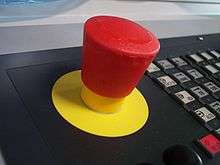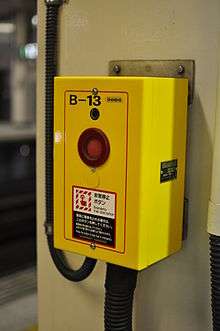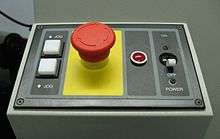Kill switch
A kill switch, also known as an emergency stop (e-stop), emergency off (EMO) and as an emergency power off (EPO), is a safety mechanism used to shut off machinery in an emergency, when it cannot be shut down in the usual manner. Unlike a normal shut-down switch or shut-down procedure, which shuts down all systems in order and turns off the machine without damage, a kill switch is designed and configured to abort the operation as quickly as possible (even if it damages the equipment) and to be operated simply and quickly (so that even a panicked operator with impaired executive functions or a by-stander can activate it). Kill switches are usually designed to be noticeable, even to an untrained operator or a bystander.
| Kill switch | |
|---|---|
 A kill switch without a cover | |
| Classification | Mechanical component |
| Industry | Automotive, boating, energy, engineering, entertainment |
| Powered | Some are mechanical and others are powered |
Most kill switches feature a removable, protective barrier against accidental activation (e.g. a plastic cover that must be lifted or glass that must be broken), known as a mollyguard. Kill switches are features of mechanisms whose normal operation or foreseeable misuse might cause injury or death; industrial designers include kill switches because damage to or the destruction of the machinery is less important than preventing workplace injuries and deaths.
A similar system, usually called a dead man's switch, is a device intended to stop a machine (or activate one) if the human operator becomes incapacitated, and is a form of fail-safe. They are commonly used in industrial applications (e.g., locomotives, tower cranes, freight elevators) and consumer applications (e.g., lawn mowers, tractors, personal water craft, outboard motors, snowblowers, motorcycles and snowmobiles). The switch in these cases is held by the user, and turns off the machine if they let go. Some riding lawnmowers have a kill switch in the seat which stops the engine and blade if the operator's weight is no longer on the seat.
Vehicles

On railways, an emergency stop is a full application of the brakes in order to bring a train to a stop as quickly as possible. This occurs either by a manual emergency stop activation, such as a button being pushed on the train to start the emergency stop, or on some trains automatically, when the train has passed a red signal or the driver has failed to respond to warnings to check that he/she is still alert, which is known as a dead man's switch. A similar mechanism is the watchdog timer.
In large ships, an emergency stop button pulls the countershaft for the fuel pumps to the stop position, cutting off the fuel supply and stopping the engines. With a controllable-pitch propeller, the stop button may declutch the engine from the propeller.
NASCAR requires all their stock cars to be equipped with a steering wheel-mounted kill switch, in case the accelerator pedal sticks and the driver needs to shut down the engine.
Kill switches are also used on land vehicles as an anti-theft system and as an emergency power off. Such devices are often placed in bait cars and configured so that observing police can trigger the switch remotely.
A related concept is the dead man's switch, where the operator must be holding a button or lever any time the vehicle is operating. A common example of this is the kill switches used by boaters and jetskiers wherein a cord connects the kill switch to the operator (usually by the operator's life jacket or clothing), and if the operator is thrown overboard in an accident, the cord will pull the switch and immediately shut down the vessel's engine. This prevents it from becoming a runaway vessel that could impose a danger to other vessels or swimmers at sea, and allows the operator to swim back to the vessel and re-board it without the risk of being injured by the boat's propeller. A similar device is featured on most lawnmowers: a lever on the handle either disables the ignition system and applies a brake to the flywheel (on a gasoline lawnmower), or cuts the power to the motor (on an electric lawnmower), as long as it is not held down.
Monster Truck Racing Association requires all of their monster trucks to be equipped with kill switches (either remote or in cab), in case the monster truck loses control and the driver needs to shut off the engine. Monster trucks' kill switches are tested before races.
Pioneer-era planes and World War I aircraft
Early aviators using rotary engine-powered aircraft from the beginnings of their use in 1908, up through the end of World War I in 1918 had what could be called a reversed functionality version of the "dead man's switch" for cutting the ignition voltage to the spark plugs on such a power-plant, to give a degree of in-flight speed control for a rotary engine. This was often called a "blip switch" or "coupe switch" (from the French term coupez, or "cut") and when not being pressed, allowed the high voltage from the engine's magnetos to operate the ignition with normal engine operation in flight — pressing the "blip switch" cut the flow of high voltage from the magnetos, stopping the combustion process in the cylinders. When such a "blip switch" was intermittently used on landing approach, this allowed a limited degree of engine speed control, as rotary engines generally did not have a conventional throttle in their carburettors to regulate engine speed, but only for governing the fuel-air ratio for start-up and full-speed operation.
Industrial machinery

On large industrial machines, an emergency stop button is typically located on the panel, and possibly in several other areas of the machine. Often, an emergency stop is made wireless using a remote control. This provides a rapid means to disconnect the energy source of the device to protect workers.[1] For fail-safe operation, the emergency stop button is a normally closed switch, which ensures that a broken wire will not prevent it from being activated, but may accidentally activate the emergency stop.
In the European Union, most types of machinery are required to be equipped with an emergency stop according to the Directive 2006/42/EC. Exceptions apply for machinery in which an emergency stop would not lessen the risk as well as for portable hand-held/hand-guided machinery.
Nuclear power plants
A kill switch in a nuclear reactor plant is called SCRAM. It is usually characterized as an acronym for "safety control rod axe man".
Machine tools
The kill switch is also used on such things as band saws and static belt sanders, pillar drills and lathes.
Fuel stations and road vehicles
A kill switch is also used for gasoline pumps or any other device that pumps large amounts of explosive or flammable chemicals. There is commonly a single kill switch for all pumps at a pumping station.
Elevators and escalators
Elevators often have a red two-way button on the control panel which is either marked "Emergency Stop" or "Run/Stop". Normally, the button is in the "up" or unpushed position, allowing the elevator to "run" in normal service. When the button is pushed, the elevator comes to an immediate stop. When the button is pulled back out, it resumes normal service, thus the reason for the use of the phrase "Run/Stop". Escalators will typically have a key-operated control that will turn the escalator off, or change its direction to up or down. Next to the key switch will be a red "Emergency Stop" button, which is used in the event of equipment failure, or where there is a potential for injury, such as when someone's shoe gets stuck in the "comb" at the top or bottom of the escalator and there is a risk of serious injury. The key switch is used to return the escalator to service after it has been stopped.
Gym
Treadmills often use a safety key with one end magnetically attached to the machine and the other end clipped to the user's waist. If the safety key is pulled out, such as in the event of a fall, the treadmill stops immediately. In other cases, some other treadmills have a more traditional kill switch, often mounted towards the rear of one of the hand railings.
Amusement rides
The emergency stop on an amusement ride is similar to that on industrial equipment. Typically brakes on a ride are designed to be disengaged when power is applied; disconnecting power will cause all brakes to engage. Most amusement rides have a computer that can, similar to the rail example provided above, engage the emergency stop when such a ride is determined to be out of operating specification.
Software
By analogy to physical kill switches, "kill switch" can be used to refer to a mechanism incorporated in software. By such its manufacturer or licensor may be able to disable it, for example if the product is withdrawn, or a maintenance fee has not been paid, or a device has been lost or stolen.[2][3] It can also refer to kill switches for the stopping of malware such as in the WannaCry ransomware attack.[4][5]
There also is a debate about implementing kill switches in robots[6] and advanced artificial intelligence systems.[7]
Wikipedia bots have kill switches due to the possibility of them causing massive vandalism.
Smartphones
In smartphones, a kill switch is a security feature that allows the phone's owner to remotely render the smartphone inoperable if it is lost or stolen. From 2015 this feature is legally required in California for smartphones.[8]
There are also hardware kill switches on some phones, like PinePhone, where the user can by moving a hardware switch inside the phone, disable some hardware, like camera, micrphone, Wifi or LTE.[9]
Military
French and Israeli electronic warfare units use kill switches to disable opponents' military systems.[10][11]
See also
- Hardware Trojan – malware embedded in hardware; harder to detect and fix than software vulnerabilities
- Internet kill switch – Single shut off mechanism for all Internet traffic
- Security switch – Hardware device to protect computers, laptops, smartphones and similar devices from unauthorized access or operation
- Blue light station – Combined emergency telephone and emergency power-off switch in rapid transit stations and other points along electrified railways
- USBKill – Anti-forensic software designed to react to unfamiliar USB devices
- SawStop a fast kill switch for table saws triggered by electrical conductivity of user's finger.
- Battleshort – Emergency override of safety features to complete a mission the opposite of a kill switch, where a system is designed to operate even if damage or injury will occur.
References
- Repas, Robert (June 22, 2010) "Designing with E-stop switches" Archived 2013-04-17 at the Wayback Machine. machinedesign.com
- Davies, Chris (19 Sep 2009). "Microsoft remote software "kill switch" confirmed". SlashGear. Retrieved 10 May 2017.
- Williams, Martyn (24 Jun 2014). "10 things to know about the smartphone kill switch". PCWorld. Retrieved 10 May 2017.
- Chan, Sewell; Scott, Mark (14 May 2017). "Cyberattack's Impact Could Worsen in 'Second Wave' of Ransomware". The New York Times. Retrieved 14 May 2017.
- "Warning: Blockbuster 'WannaCry' malware could just be getting started". NBC News. Retrieved 14 May 2017.
- Kottasova, Ivana (12 January 2017). "Europe calls for mandatory 'kill switches' on robots". CNNMoney. Retrieved 14 May 2017.
- Larson, Selena (26 January 2017). "Killing the immortal: Why scientists are debating the life span of robots". CNNMoney. Retrieved 14 May 2017.
- https://www.washingtonpost.com/news/the-switch/wp/2014/08/27/the-smartphone-kill-switch-explained/. Missing or empty
|title=(help) - T., Raffaele (2 September 2019). "Librem 5 vs. PinePhone: comparison of two Linux smartphones". TuxPhones.
- "The Hunt for the Kill Switch". IEEE Spectrum: Technology, Engineering, and Science News. Retrieved 2017-07-13.
- Markoff, John (2010-09-26). "Stuxnet Worm Is Remarkable for Its Lack of Subtlety". The New York Times. ISSN 0362-4331. Retrieved 2017-07-13.